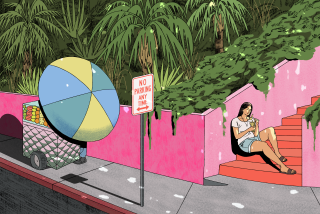BOOK REVIEW / NONFICTION : Emotional Healing Is a Two-Way Street in Psychotherapy : A SHINING AFFLICTION: A Story of Harm and Healing in Psychotherapy <i> by Annie G. Rogers</i> ; Viking $23.95, 322 pages
- Share via
A psychotherapist who believes in angels is less a contradiction in terms nowadays than he or she once might have seemed, but Harvard psychology professor Annie G. Rogers does not merely believe in angels--she actually sees them.
The first angel we encounter in “A Shining Affliction” is an ethereal young girl who suddenly appears beside the author in the stacks of the university library and then disappears into a “spinning light of dust motes.”
Writes Rogers: “You could say, ‘The child did not exist. . . .’ On the other hand, some angels yearn to be recognized, but can’t bear to be exposed too long in the light they themselves cast over the world.”
As Rogers beckons us into even more intimate places in her life and work, we come to realize that angels abound in “A Shining Affliction,” at least if we define the term broadly enough to include the redemptive role that both therapist and patient sometimes play in a successful psychotherapy.
“A Shining Affliction” is, on one level, a memoir of Rogers’ clinical internship as a doctoral candidate in psychology at a treatment center for disturbed children outside Chicago. But it is also the effort of a troubled but earnest seeker to delve deeply into the workings of the human mind and spirit, to ponder what actually happens when a therapist and a patient follow each other along what Rogers calls “a fragile trace of love and knowledge.”
She describes her experiences with several key figures, including Ben, the “untreatable” 5-year-old boy who is assigned to Rogers as a discipline case study, and Dr. Sam Blumenfeld, a psychoanalyst who rescues Rogers from her own failed therapy and a catastrophic breakdown.
“A Shining Affliction” is sturdy and lyrical at the same time, a case history that occasionally soars into a sublime meditation on “terror, want, arousal, love, shame.” Butwhat makes the book so extraordinary are Rogers’ courage and honesty, her gift at putting the most subtle emotions and terrifying experiences into plain words, and her willingness to reveal exactly what goes on in the sometimes mysterious encounter between therapist and patient.
To Rogers, then, the very process of therapy is a ritual of reciprocal storytelling, and the whole point of storytelling is to create a “central place of undisturbed mystery” where the demons of one’s childhood and one’s nightmares may be safely scrutinized.
“We played together and made a new sanctuary within each of our stories,” writes Rogers of her work with young Ben, “a place where love survives unbearable loss.”
For example, Rogers comes to recognize that Ben, who is given to rages and even physical assault, has something to teach her--and the play therapy that Rogers describes with a scientist’s precision becomes “a powerful human drama, a drama that neither one of us can play out (or even imagine) alone.”
“I’m putting magic back in here!” says Ben, as he waves a red stick from a set of Tinkertoys as if it were a wand--and his playful words suggest a deeper truth.
Rogers is no less rigorous when it comes to describing her breakdown, a descent into madness that began when she showed up at a psychotherapy session with her former therapist carrying a knife and a gun. She knows the words and phrases to define her mental state--”memory repression” and “psychogenic fugue”--but the breakdown is, for Rogers, quite literally an out-of-body experience.
“The top of my head lifts off (a strange sensation),” Rogers writes, and then she slips into the third-person: “Her own body is another body of light, tapping out messages in freezing and burning codes to unseen presences. What is this world she is about to enter?”
Ben and Blumenfeld, as it turns out, are angels of deliverance for Rogers--and they are not the only ones in “A Shining Affliction.” Just as Rogers is a scientist, a scholar, a poet and a storyteller, Rogers comes to see that Ben, her patient, and Blumenfeld, her analyst, are both healers.
“Healing is always two-sided, isn’t it?” says Blumenfeld to Rogers, a phrase that sums up her credo as a therapist. And, somehow, the notion seems more self-evident at the end of “A Shining Affliction” than it does when we first pick the book up.
More to Read
Sign up for our Book Club newsletter
Get the latest news, events and more from the Los Angeles Times Book Club, and help us get L.A. reading and talking.
You may occasionally receive promotional content from the Los Angeles Times.







